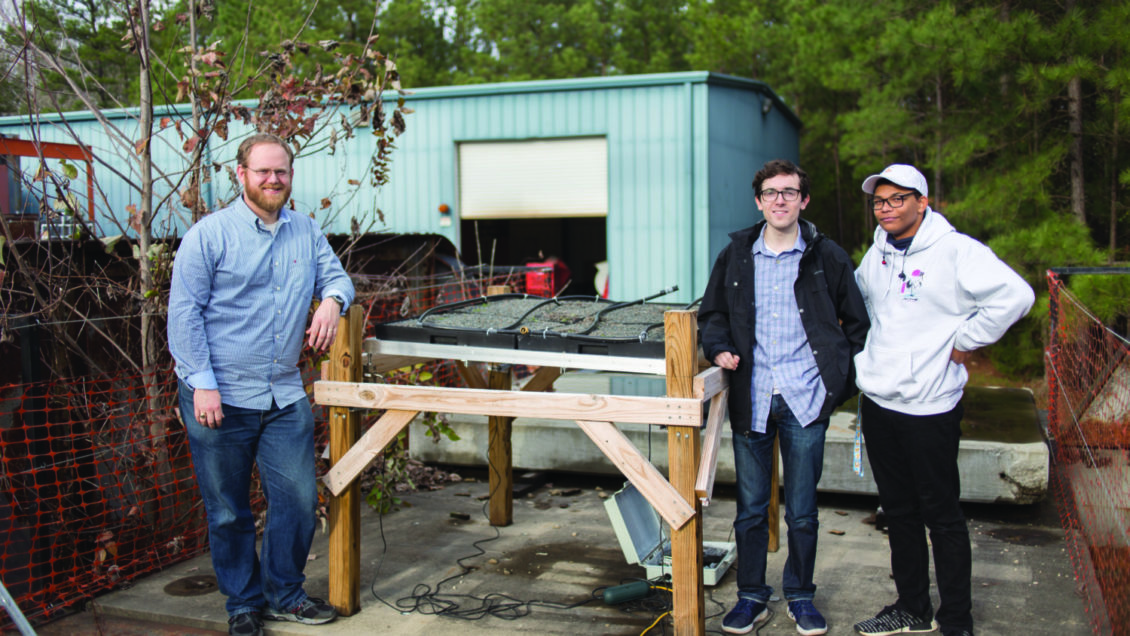When looking for flora and fauna in a city, it may be a good idea to look up. In urban landscapes, placing gardens on rooftops is a growing trend. Even Clemson University’s campus hosts two green roofs, on Lee III and the Watt Family Innovation Center. A green roof is one covered with soil and plants that are watered with rainwater and controlled irrigation systems. Succulents are often used to regulate the roof’s temperature and provide an aesthetically pleasing, variegated landscape. The Coupling Green Roofs, Rainwater Cisterns and Urban Agriculture Creative Inquiry project, mentored by Dr. William Martin in the General Engineering Program, is working to design a self-sufficient garden system for rooftops.

Donovan Rice, a sophomore computer engineering major, enjoys the practical applications of this project such as the coding skills he learns in Python and Ubuntu operating systems. Rice hopes their work is laying a foundation for systems that can eventually be implemented world-wide. “After completing our first prototype garden plot, I’d like to see this CI design a consumer-friendly, mass-producible garden plot that can be used worldwide to grow environmentally-friendly gardens in urban areas,” Rice says.
Currently, the team is addressing water usage in the green roof system. Cisterns (large water barrels) and green roofs are both ineffective systems when used individually. On a green roof similar to Lee III only 10% of rainwater is absorbed by the soil. The rest is diverted to storm water drains. The Creative Inquiry team thinks they can improve the system by combining it with cistern systems. Both systems come with a large installation cost. “The measurable benefits are not always worth the cost,” Martin says. Capturing all excess roof water will reduce or eliminate the need for storm water drains entirely which will make having a green roof more feasible.
For testing purposes, the team designed and built a four-foot-square tabletop roof model with dirt but no plants. They are investigating water accumulation in the system by continuously recording the weight of the model using electronic load cells under the legs of the table. This weight changes with water saturation. Analyzing this data allows the team to understand the kinetics and water demands in the system over time.
Students can choose to work on the construction or software side of the project, but they all work together to attach the cistern to the model system. The software team writes code to program the system to irrigate the green roof after a specific number of rainless days or when the weight of the system is at a minimum, indicating there is not enough water. When relying solely on cistern water, the system will be a completely closed loop. Once the model system works properly, the team will start growing plants. The next big leap will then be scaling up to a roof-sized system.
Green roof systems are a testament to the engineers’ ability to create a fully functioning ecosystem on top of a building. Improving the current systems in use for water retention and storage can decrease runoff and reduce flooding and related impacts. This new system will increase sustainability and decrease the costs of a green roof system. Eventually, the team hopes to see students maintaining closed loop green roofs on campus to give them a greater sense of ownership and pride in their buildings, school and community.
This story was originally featured in Decipher 2019– Clemson’s Creative Inquiry Magazine.
Get in touch and we will connect you with the author or another expert.
Or email us at news@clemson.edu

